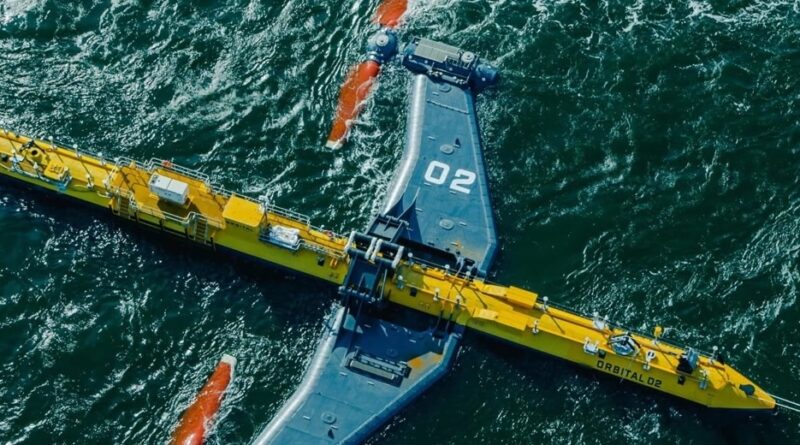
Tidal energy innovators have faced down a mountain of obstacles over the the years, and finally signs of commercial application are beginning to emerge. In an interesting twist, the US could be among the first nations to take advantage of the reliable, 24/7 renewable energy potential of tides — if not immediately, then perhaps after the 2028 election cycle. Waiting another four years or so for tidal energy to come to US waters is not an ideal situation in terms of accelerating the nation’s energy transition, but it does accord with the slow pace of uptake globally.
After all, tidal researchers have been grappling with costs as well as technology hurdles for decades. Environmental considerations and competition from other marine traffic can also contribute to long delays if not outright cancellations. With that in mind, let’s take a look at a tidal energy project under the wing of the Orcas Power and Light Cooperative, a member-owned nonprofit electric cooperative serving the island community of San Juan County in Washington State.

Electric cooperatives are a ubiquitous feature in the US landscape, having been authorized by a Depression-era economic development program aimed at bringing electricity to deprived rural communities that private utilities were neglecting. While electric coops can be encumbered by fossil energy commitments, they are also empowered to seek out innovative new solutions for local energy challenges, and tidal energy makes the cut. OPALCO gets most of its power from undersea cables connecting it to mainland Washington.
The coop has been scouting for more resilient, local alternatives , as the Pacific Northwest region faces potential shortfalls due to increased demand and the decommissioning of coal power plants. The tidal project began to take shape in 2018, when OPALCO began investigating different kinds of tidal devices. The idea soon coalesced around a floating tidal harvesting device developed by the Scottish firm Orbital Marine Power, to be located in the Rosario Strait.
“OPALCO found the floating turbine technology to have the most promise considering the service ability, marine traffic and environmental parameters,” the coop explains. If the concept grows legs, OPALCO anticipates that Rosario Strait can host multiple tidal energy devices. The coop also makes a strong case for the US to launch itself into tidal energy: “With water being 800 times the density of air, tidal stream energy is to the northwest what solar is to the southwest.
While solar is minimal in the winter, tidal power is strong and predictable year-round, but more importantly, it can be firmed with a small fraction of the storage, solar, or wind would require.” To reinforce its case for tidal energy, OPALCO also notes that Orbital’s turbines could be manufactured in the US, deploying domestic supply chain sourcing. As is typical of the slow pace of tidal energy development, Orbital’s turbines have yet to hit the waters of the Rosario Strait.
Working with the Pacific Northwest National Laboratory and the University of Washington, Orbital received grants from the US Department of Energy to complete site and engineering assessments in 2021. In March of 2024, Orbital celebrated official confirmation that it is the OPALCO technology partner for the tidal energy project. “Building on a memorandum of understanding (MOU) signed between Orbital and OPALCO in 2021, this latest update follows the US Department of Energy (DOE) shortlisting two marine energy projects to receive $6 million for the development of a tidal energy research, development, and demonstration pilot site,” Orbital explained, indicating that it will have to compete for the next level of funding.
In 2024 OPALCO also issued an update, noting that it received funding from the US Department of Energy to continue investigating the feasibility of harvesting tidal energy for its ratepayers. The 12-month grant period started in June of 2024, covering environmental studies as well as an assessment of tidal flows and other key elements. All else being equal, the grant period will end this June.
In the meantime, US energy policy has undergone a sea change since January, when President Trump took office on the heels of a campaign promise to support more fossil energy development. Whether or not the Energy Department continues to fund tidal energy projects in the US remains to be seen. However, interest in tidal energy is growing in other parts of the world, and it’s a big world out there.
Alongside its partnership with OPALCO, Orbital has also been working with the renewable energy certification organization Lloyd’s Register to achieve IECRE (International Electrotechnical Commission for Renewable Energy) approval on the feasibility of its next-generation O2-X TEC turbine, billed as “the world’s largest tidal energy converter” at a capacity of 2.4 megawatts. Work on the complex certification process got under way in September last year.
On April 1, LR announced that IECRE came through with a Feasibility Statement for the O2-X, representing a significant milestone towards full certification. “As an evolution of the company’s existing O2 turbine, currently deployed in the Fall of Warness, Scotland, the O2-X is expected to generate 2.4MW of predictable, renewable energy from tidal flows,” LR explained, taking note of Orbital’s existing pilot project in the UK.
The Fall of Warness hosts a government funded, grid-connected test site for tidal energy devices. Here in the US, the government has also invested a considerable amount of taxpayer dollars in developing marine energy test sites, including support for new wave energy harvesting devices as well as tidal and run-of-the-river energy harvesting . It would be a shame to see all those public resources go to waste if the US drops the tidal energy ball along with other forms of marine energy.
However, President Trump has already demonstrated a willingness to slough off domestic renewable energy industries in the service of a 20th century fossil energy profile, most notably when he suspended the US offshore wind lease program. Of course, stopping renewable energy development in other parts of the world is not so easily done. Offshore wind stakeholders in the US have already begun to pack up and take their business elsewhere.
Tidal energy innovators can follow suit. On a brighter note, Election Day 2028 is less than four years away. Once the time the results are tallied, US energy policy could once again favor renewables.
If you have any thoughts about that, drop a note in the comment thread. Better yet, find your representatives in Congress and let them know what you think. Photo (cropped): The US could be among the first nations to install a new floating tidal energy turbine billed as the largest tidal device of its kind in the world, though that may depend on the results of the next Presidential election (courtesy of Lloyd’s Register).
CleanTechnica's Comment Policy LinkedIn WhatsApp Facebook Bluesky Email Reddit.








_8.jpg?itok=wp-xhXRB)





